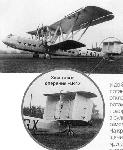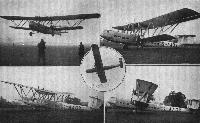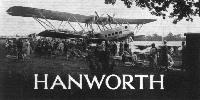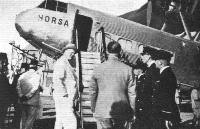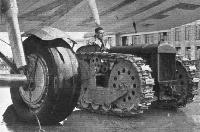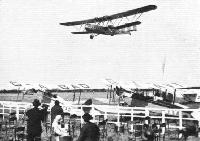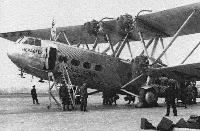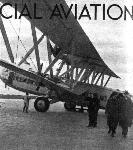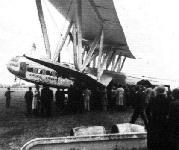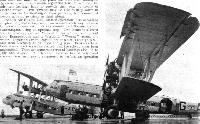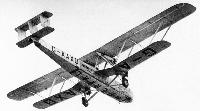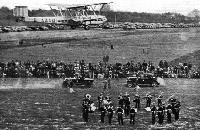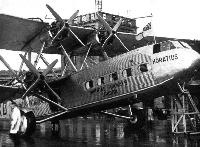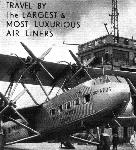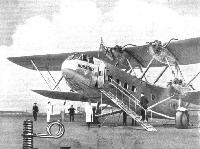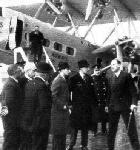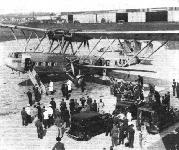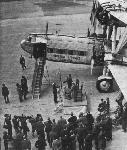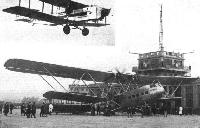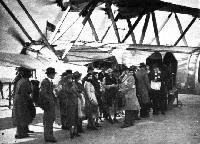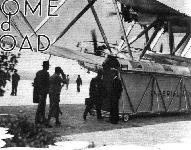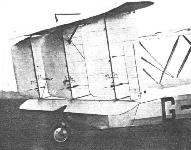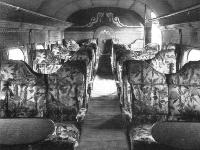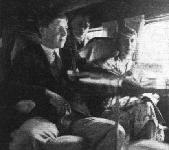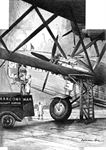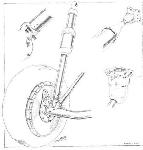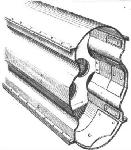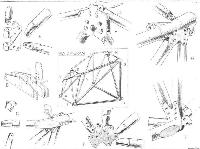
Описание
Страна : Великобритания
Год : 1930
Транспортный самолет с экипажем из трех человек
Handley Page H.P.42 и H.P.45
Авиакомпания "Imperial Airways" испытывала необходимость в новом самолете для своих авиалиний, призванных связать различные уголки Британской Империи. В начале 1928 года компания "Handley Page" получила от нее контракт на четыре самолета H.P.42E (Eastern - Восточный) и четыре H.P.42W (Western - Западный) для эксплуатации на дальних маршрутах авиакомпании. Через несколько лет обозначение модели H.P.42W было изменено на H.P.45.
Самолеты являлись бипланами с крыльями разного размаха, связанными массивной ферменной конструкцией Уоррена. Машина была цельнометаллической конструкции, кроме полотняной обшивки крыльев, стабилизатора и задней части фюзеляжа. Самолет имел трехкилевое бипланное хвостовое оперение с рулями направления, шасси с хвостовым колесом и широко расставленными основными стойками. Также машина получила силовую установку из четырех звездообразных ПД Bristol Jupiter (на Н.P.42E - четыре Jupiter XIF мощностью 490 л. с., а на H.P.42W - четыре двигателя с турбокомпрессором Jupiter XFBM), два из которых ставились на верхнем крыле, и по одному - с каждой стороны фюзеляжа на нижнем крыле. Экипаж размещался в закрытой кабине вверху носовой части фюзеляжа, а пассажиры - в двух салонах перед крылом и позади него. Вместимость салонов могла меняться. Самолеты H.P.42E на линиях в Индию и Южную Африку вмещали шесть (затем 12) пассажиров в переднем салоне и 12 в заднем; каждый из самолетов H.P.42W, применявшихся на европейских маршрутах, имел 18 мест в переднем салоне и 20 в заднем, но их багажный отсек был уменьшен. Первый полет самолета H.P.42E, названного Hannibal, состоялся 14 ноября 1930 года.
Первый самолет для эксплуатации на европейских авиалиниях - Heracles - был поставлен в сентябре 1931 года, остальные авиалайнеры носили имена: для H.P.42E - Horsa, Hanno и Hadrian, а для H.P.42W - имена Horatius, Hengist и Helena. В эксплуатации самолеты заслужили хорошую репутацию за счет высокой надежности и простоты эксплуатации и обслуживания, но скорость машин была, конечно, слишком низкой. Авиалайнеры были сняты с эксплуатации 1 сентября 1939 года, почти десять лет прослужив без единой авиакатастрофы.
ТАКТИКО-ТЕХНИЧЕСКИЕ ХАРАКТЕРИСТИКИ
Handley Page H.P.42W (H.P.45)
Тип: транспортный самолет с экипажем из трех человек
Силовая установка: четыре звездообразных ПД Bristol Jupiter XFBM мощностью по 555 л. с. (414 кВт)
Летные характеристики: максимальная скорость на оптимальной высоте 204 км/ч; крейсерская скорость на оптимальной высоте 153-169 км/ч; начальная скороподъемность 204 м/мин; практический потолок - нет данных; дальность полета 805 км
Масса: пустого 8047 кг; максимальная взлетная 12701 кг
Размеры: размах верхнего, большего крыла 39,62 м; длина 28,09 м; высота 8,23 м; площадь крыльев 277,68 м2
Полезная нагрузка: см. выше
Описание:
- Handley Page H.P.42 и H.P.45
- Flight, June 1929
BRITISH AIRCRAFT AT OLYMPIA - Flight, November 1932
British Aircraft - Flight, July 1933
THE HANDLEY PAGE "HEYFORD"
Фотографии
-
Мировая Авиация 149
Регистрационный номер: G-AAXE [12] G-AAXE Hengist первоначально получил в авиакомпании "imperial Airways" название Hesperides, но вскоре оно было изменено - писать и проговаривать это название десятки и сотни раз в день было настоящим испытанием.
-
Мировая Авиация 40
Регистрационный номер: G-AAUE [13] Получивший военную камуфлированную окраску, но сохранивший гражданскую регистрацию G-AAUE, "Hadrian" стал последним летавшим H.P.42. Так самолет выглядел, когда состоял на вооружении 271-й авиаэскадрильи.
H.P.42 "Эдриан" в камуфлированной окраске Королевских ВВС вошёл в состав 261-й эскадрильи, но к месту её дислокации на Мальте так и не прибыл, так как был разбит ураганом а аэродроме Донкастере 6 декабря 1940 года.
-
Flight 1935-05 / Flight
Регистрационный номер: G-AAGX [22] The Handley Page H.P.42 "Hannibal" (4 Bristol "Jupiters") landing at Croydon. Note “Imperial Airways” lettering along the bottom of the fuselage.
Handley Page HP.42E G-AAGX, Imperial Airways' "Hannibal", which was lost at sea on 1.3.40. -
Aeroplane Monthly 1982-12 / D.Middleton - Maj James Cordes /Test Pilot Profile/ (5)
Регистрационный номер: G-AAGX [22] The prototype H. P.42, G-AAGX, was jointly tested by Maj Cordes and Tom Harry England in November 1930 from Radlett, Hertfordshire. Named Hannibal this HP.42 flew with Imperial Airways until it was lost at sea over the Gulf of Oman on March 1, 1940.
-
Aeroplane Monthly 1985-08 / J.Stroud - Wings of Peace
Регистрационный номер: G-AAGX [22] Hannibal on a test flight, with crude artificial horizon ahead of the nose. The oleo legs are still unfaired but mudguards are in place.
-
Flight 1931-07 / Flight
Регистрационный номер: G-AAGX [22] COMPLETE WITH CERTIFICATE OF AIRWORTHINESS: The Handley Page "Hannibal" (four Jupiters) leaving Hanworth for Croydon.
"Owing to his great size it is difficult to appreciate Hannibal's proportions, except at a considerable distance; as seen from the ground, or preferably from another plane, he appears quite graceful in flight." -
Flight 1930-11 / Flight
Регистрационный номер: G-AAGX [22] HANDLEY PAGE 42-SEATER: The photographs show this new large passenger aeroplane on the ground and ni the air. In front of the wings is a saloon for 18 passengers while the rear saloon will accommodate 20 more. Machines of this type will be used by Imperial Airways on the routes Croydon-Salonika and Cairo-Karachi.
-
Flight 1939-06 / Flight Advertisements
Регистрационный номер: G-AAGX [22] The first of eight H.P.42s supplied to Imperial Airways, who ordered the machines "off the drawing board." The “42” will go down in aviation history as a really outstanding aeroplane.
-
Flight 1931-02 / Flight
Регистрационный номер: G-AAGX [22] THE HANDLEY-PAGE "HANNIBAL": Fitted with 4 Bristol "Jupiter" engines, this machine, which was designed to carry 42 passengers, is intended for the European and Cairo-Karachi sections of the Empire air routes next summer.
-
Air Pictorial 1977-12 / J.Hunt - Aviation in the Sudan - before independence
Регистрационный номер: G-AAGX [22] In November 1932 Imperial Airways introduced the Handley Page H.P.42E on their Cairo-Cape route; G-AAGX "Hannibal" Illus.
-
Aeroplane Monthly 1985-08 / J.Stroud - Wings of Peace
Регистрационный номер: G-AAGX [22] Hannibal at Radlett, probably on November 17, 1930. The oleo leg is unfaired and the mudguards have not been fitted. The diagonal of the N strut was replaced with wire bracing.
-
Aeroplane Monthly 1976-04 / P.Moss - What happened to Hannibal?
Регистрационный номер: G-AAGX [22] -
Flight 1935-10 / Flight
Регистрационный номер: G-AAGX [22] The Handley Page "Hannibal" class the first really large British commercial aeroplane, set a new standard in comfort for passengers.
-
Flight 1931-06 / Flight
Регистрационный номер: G-AAGX [22] An unusual touch was lent to the Parliamentary visit to Hanworth by the presence of a replica of the old Bleriot monoplane, Type XI, and the latest commercial aircraft, the Handley Page "Hannibal." Many of the visitors saw, for the first time, a Bleriot monoplane in flight
-
История Авиации 37 / А.Рудакова - Шикарная "Чайка" "Имперских авиалиний" /Коммерческие перевозки/
Регистрационный номер: G-AAGX [22] HP-42 на аэродроме в Лидде, 1934 год. Обратите внимание на качество аэродромного покрытия! И это в тысячах миль от метрополии!..
-
Aeroplane Monthly 1981-02 / Radlett /Gone but not forgotten/ (9)
Регистрационный номер: G-AAGX [22] The scene in the main hangar during the official opening on July 7, 1930 with the fuselage of H.P.42 G-AAGX still under construction and the remains of the 1910 Yellow Peril nestling under it.
Prince George making his speech. The remains of the 1910 "Yellow Peril" stand beside the fuselage of a 40-seater passenger machine.Другие самолёты на фотографии: Handley Page Type A/C/D (H.P.1/3/4) - Великобритания - 1910
-
Aeroplane Monthly 1985-08 / J.Stroud - Wings of Peace
Регистрационный номер: G-AAUC [5] G-AAUC Horsa flying near Kisumu, the African terminus for the H.P.42s.
-
Flight 1933-09 / Flight
Регистрационный номер: G-AAUC [5] Malakal Aerodrome (Sudan): Imperial Airways' Horsa landing on the finished runway. The machine is actually touching the southern turning circle, and the reeds seen in the background are in the backwater of the Nile, which runs beside the aerodrome.
-
Aeroplane Monthly 1985-09 / Personal album
Регистрационный номер: G-AAUC [5] Handley Page H.P.42E G-AAUC Horsa, somewhere in Africa in the mid-Thirties. The aircraft was first registered to Imperial Airways Ltd on September 19, 1931 and remained in service with the airline until it was impressed into RAF service as AS981 in May 1940.
-
Flight 1934-06 / Flight
Регистрационный номер: G-AAUC [5] THE PENNANT IN EGYPT: Sir Miles Lampson, High Commissioner at Cairo, inspects the crew of the Imperial Airways airliner Horsa, after presenting the Royal Air Mail Pennant. Later he went up for a flight over Cairo.
-
Air Pictorial 1995-04 / G.Swanborough - British aircraft at war, 1939-1945 (16)
Регистрационный номер: G-AAUC [5] The Handley Page H.P.42E G-AAUC after impressment as AS981, in service with No 271 Sqn at Doncaster in 1940.
-
История Авиации 37 / А.Рудакова - Шикарная "Чайка" "Имперских авиалиний" /Коммерческие перевозки/
Регистрационный номер: G-AAUD [18] "Ханно" перед вылетом из Газы в Галиполи, 1932 год.
-
Мировая Авиация 40
Регистрационный номер: G-AAUD [18] "Hanno" заправляется топливом в Бахрейне. По маршруту полета была организована сеть пунктов дозаправки. Некоторые имели обслуживающий персонал, некоторые представляли собой просто склады.
-
История Авиации 37 / А.Рудакова - Шикарная "Чайка" "Имперских авиалиний" /Коммерческие перевозки/
Регистрационный номер: G-AAUD [18] H.P.42 "Ханно" на аэродроме Симак (Галилея, Палестина), октябрь 1931 года.
-
Aeroplane Monthly 1996-11 / J.Stroud - Hanno
Регистрационный номер: G-AAUD [18] -
Aeroplane Monthly 1996-11 / J.Stroud - Hanno
Регистрационный номер: G-AAUD [18] Hanno’s Bristol Jupiter engines are run up before take-off during the aircraft’s service on Imperial Airways’ Eastern route.
-
История Авиации 37 / А.Рудакова - Шикарная "Чайка" "Имперских авиалиний" /Коммерческие перевозки/
Регистрационный номер: G-AAUD [18] На этом фото запечатлен H.P.42 "Ханно" с ранним бортовым кодом G-AAUZ (G-AAUD ???) перед ночным вылетом из лондонского аэропорта Кройдон, 1931 год
-
История Авиации 37 / А.Рудакова - Шикарная "Чайка" "Имперских авиалиний" /Коммерческие перевозки/
Регистрационный номер: G-AAUD [18] -
История Авиации 37 / А.Рудакова - Шикарная "Чайка" "Имперских авиалиний" /Коммерческие перевозки/
Регистрационный номер: G-AAUD [18] "Ханно" на одном из ближневосточных аэродромов в 1935 году.
-
История Авиации 37 / А.Рудакова - Шикарная "Чайка" "Имперских авиалиний" /Коммерческие перевозки/
Регистрационный номер: G-AAUD [18] Экипаж и часть пассажиров позируют на фоне H.P.42 "Ханно", который обслуживает наземный персонал на аэродроме Симак (Галилея, Палестина), октябрь 1931 года.
-
Aeroplane Monthly 1989-02 / Skywriters
Регистрационный номер: G-AAUD [18] A Lockheed 10 Electra, Bloch 221 and an HP.42 diverted to RAF Kenley during bad weather in 1938.
Другие самолёты на фотографии: Bloch MB.220 - Франция - 1936Lockheed Electra 10 - США - 1934
-
Aeroplane Monthly 1974-03 / P.Moss - Wings for the Empire (3)
Регистрационный номер: G-AAUD [18] H.P.42 Hanno at Gwadar, Baluchistan. Registered G-AAUD, it was wrecked in a gale at Whitchurch in March 1940.
-
Flight 1933-08 / Flight
Регистрационный номер: G-AAUD [18] THE KARACHI-CALCUTTA AIR MAIL: The accompanying illustrations show incidents in connection with the first air mail service between Karachi and Calcutta, which was inaugurated on July 7. Mails (635 lb.) were transferred to the Imperial Airways machine Hanno for the remaining portion of the journey to Croydon.
-
Flight 1933-11 / Flight
Регистрационный номер: G-AAUE [13] FROM MONOPLANE TO BIPLANE: From Karachi the journey was continued in Hannibal, of the Handley Page 42 class, similar to Hadrian shown above.
-
Aeroplane Monthly 1985-08 / J.Stroud - Wings of Peace
Регистрационный номер: G-AAUE [13] G-AAUE Hadrian at Khartoum. The aircraft was delivered to Imperial airways on July 10,1931, and ended its life wrecked in a gale at Doncaster on December 4, 1940.
-
История Авиации 37 / А.Рудакова - Шикарная "Чайка" "Имперских авиалиний" /Коммерческие перевозки/
Регистрационный номер: G-AAUE [13] H.P.42 на аэродроме в Кении, 1936 год.
-
Aviation Historian 36 / R.Pegram - The golden age?
Регистрационный номер: G-AAUE [13] A trio of typical aircraft operating commercial services in Africa in the 1930s, including two of IAL’s most important landplanes; Handley Page H.P.42E G-AAUE Hadrian (furthest right) and Armstrong Whitworth AW.15 Atalanta G-ABTJ Artemis, behind Wilson Airways’ de Havilland D.H.84 Dragon VP-KBG, at Kisumu in Kenya.
Другие самолёты на фотографии: Armstrong Whitworth Atalanta / A.W.15 - Великобритания - 1932De Havilland Dragon / D.H.84 - Великобритания - 1932
-
Aeroplane Monthly 1985-09 / Personal album
Регистрационный номер: G-AAUE [13] Handley Page H.P.42E G-AAUE Hadrian with Armstrong Whitworth Atalanta G-ABTH Andromeda at an unknown African aerodrome in the mid-Thirties. This Atalanta was originally put on the Cape Town - Kisumu route in February 1933. The aircraft was eventually withdrawn from Imperial Airways service at Alexandria after suffering mainspar damage.
Другие самолёты на фотографии: Armstrong Whitworth Atalanta / A.W.15 - Великобритания - 1932
-
Flight 1931-09 / Flight
Регистрационный номер: G-AAUE [13] DIGNITY AND IMPUDENCE: The Comper Swift (Pobjoy R) sheltering under the bow of Hadrian at Croydon just before Flt. Lt. N. Comper set out for Italy.
Другие самолёты на фотографии: Comper Swift / CLA.7 - Великобритания - 1930
-
Flight 1931-07 / Flight
Регистрационный номер: G-AAUE [13] JACK-THE-GIANT HAULER: This is the Fordson caterpillar tractor, now used at Croydon for hauling the giant airliners about.
-
Aeroplane Monthly 1986-11 / Personal album
Регистрационный номер: G-AAUE [13] Imperial Airways' Handley Page H.P.42 G-AAUE Hannibal is seen taking on November 24, 1931 bound for Egypt. This aircraft was lost over the Gulf of Oman, between Jask and Sharjah, on March 1, 1940.
-
История Авиации 37 / А.Рудакова - Шикарная "Чайка" "Имперских авиалиний" /Коммерческие перевозки/
Регистрационный номер: G-AAUE [13] H.P.42 "Эдриан" в камуфлированной окраске Королевских ВВС вошёл в состав 261-й эскадрильи, но к месту её дислокации на Мальте так и не прибыл, так как был разбит ураганом а аэродроме Донкастере 6 декабря 1940 года.
-
Aeroplane Monthly 1981-02 / Radlett /Gone but not forgotten/ (9)
Регистрационный номер: G-AAXC [26] H.P.42 G-AAXC leaves Radlett on its first flight, summer 1931.
-
Aeroplane Monthly 1985-08 / J.Stroud - Wings of Peace
Регистрационный номер: G-AAXC [26] Handley Page H.P.42 G-AAXC Heracles on test at Radlett. Note the aerofoil elevator balance and the underwing outboard exhaust pipes on the upper engines.
-
Air Enthusiast 2000-11 / G.Warner - Founding Fathers (2)
Регистрационный номер: G-AAXC [26] Arguably that the most successful landplane to operate in Imperial Airways livery were biplanes - the eight magnificent and sedate HP.42s - G-AAXC 'Heracles' illustrated.
-
Aeroplane Monthly 1981-07 / Whitchurch /Gone but not forgotten/ (10)
Регистрационный номер: G-AAXC [26] H.P.42W, G-AAXC, arriving at the Bristol & Wessex Garden Party on October 1, 1932, with Captain O. P. Jones in command.
-
Flight 1932-10 / Flight
Регистрационный номер: G-AAXC [26] Heracles was very imposing as "she" arrived over the hangar at Bristol Airport. The broadcasting van on the left was most ably worked throughout the meeting by Mr. Dick Ashley Hall.
-
Aeroplane Monthly 1980-09 / Personal album
Регистрационный номер: G-AAXC [26] Handley Page H.P.42W G-AAXC Heracles was registered to Imperial Airways Ltd in August 1931. The 42W variant carried 38 passengers, but had less room for baggage than the standard 42E, though both were externally identical. Heracles made an unscheduled extended stay at Hanworth Park in June 1932, when one of its wheels sank into a drainage culvert while the aircraft was preparing to leave the Royal Aeronautical Society’s Garden Party. There followed many trouble-free years of service until a gale wrecked the old dear at Whitchurch, Bristol, on March 19, 1940.
-
Aeroplane Monthly 2000-12 / ??? - The Croydon Airport Society /High Society/
Регистрационный номер: G-AAXC [26] If any one aircraft encapsulates Croydon Airport in its heyday it is the Handley Page H.P.42. Here G-AAXC Heracles awaits its passengers. It was damaged beyond repair in gales at Whitchurch on March 19, 1940.
-
Flight 1932-06 / Flight
Регистрационный номер: G-AAXC [26] The Lord Mayor of London, Sir Maurice Jenks, and party make a tour of inspection of Croydon Aerodrome before flying to Lancashire in a Handley Page 42 airliner on June 6.
-
Aeroplane Monthly 1985-08 / J.Stroud - Wings of Peace
Регистрационный номер: G-AAXC [26] This view of Heracles shows the engine layout, anhedral on the lower wing, and wide-track undercarriage.
-
Мировая Авиация 40
Регистрационный номер: G-AAXC [26] Самолет Н.Р.42 хорошей аэродинамикой не отличался: лес стоек и расчалки бипланной коробки, неубираемые шасси с подкосами серьезным образом увеличивали лобовое сопротивление машины. Н. Р.42 развивал скорость немного больше, чем курьерский поезд, но в шуточной гонке Лондон-Эдинбург с трудом, но выиграл у поезда "Летучий шотландец".
-
Air Enthusiast 1972-06 / L.Coombs - Front-office evolution (2)
Регистрационный номер: G-AAXC [26] The first significant British multy-engine aeroplane with an enclosed cockpit was the H.P.42 Heracles-class of Imperial Airways airliner.
-
Aeroplane Monthly 2000-07 / J.Stroud - A million miles flown /A lifetime of flying/
Регистрационный номер: G-AAXC [26] Sixty-three-year flashback: a young John Stroud boards Handley Page H.P.45 Heracles at Le Bourget in May 1937.
-
Flight 1937-07 / Flight
Регистрационный номер: G-AAXC [26] "HERACLES," best known of Imperial Airways' H.P. 42's, last week celebrated her 1,000,000th mile in the air.
-
Flight 1932-09 / Flight
Регистрационный номер: G-AAXC [26] On the Thursday afternoon even the large seating accommodation of the H.P.42 "Heracles" was unable to cope with the demand for tea flights over London by our enthusiastic visitors.
-
Flight 1932-09 / Flight
Регистрационный номер: G-AAXC [26] AT CROYDON: The Heracles (with the Spartan "Cruiser") just before the start for Denmark.
Другие самолёты на фотографии: Spartan Cruiser - Великобритания - 1932
-
Aviation Historian 24 / R.Pegram - Imperial Airways. The 1930s: a cause for concern?
Регистрационный номер: G-AAXC [26] With Handley Page H.P.42 Heracles nosing into the picture from the right, Boulton Paul P.71A G-ACOX is prepared for a flight at Croydon. Only two examples of the P.71A feederliner were completed and both were delivered to Imperial in February 1935. Both had been lost in accidents by the end of 1936.
Другие самолёты на фотографии: Boulton Paul P.71 - Великобритания - 1935
-
Aeroplane Monthly 1990-07 / J.Stroud - Wings of Peace
Регистрационный номер: G-AAXC [26] READY FOR ACTION: The first of the passenger-carrying D.H. Albatross monoplanes at Croydon last week. Suitably posed in the background will be seen Heracles, which has done so much good work and which will still be essential for dealing with the tremendous mail loads on the Empire routes during the Christmas season. Two of the D.H. Frobisher class are expected to be ready before the middle of December; afterwards they will be put on the Zurich route.
A contrast in styles. Imperial Airways D.H.91 Frobisher at Croydon in 1939 with the Handley Page H.P.45 Heracles.Другие самолёты на фотографии: De Havilland Albatross / D.H.91 - Великобритания - 1937
-
Flight 1935-03 / Flight
Регистрационный номер: G-AAXC [26] DEMONSTRATION: One of the two Swissair Douglas machines, which were demonstrated recently at Croydon, being refuelled beside the Imperial Heracles. Actually, the "Scylla" class will probably be used, as last year, for our own part of the Zurich service. The Government has offered a prize of ?25,000 to encourage the production of medium-sized commercial machines.
Другие самолёты на фотографии: Douglas DC-1 / DC-2 / C-32 / C-39 - США - 1933
-
Flight 1935-05 / Flight
Регистрационный номер: G-AAXC [26] REFUELLING: An impressive picture of the two largest types in European passenger service - the Handley-Page "Heracles" and the Short "Scylla' - on the tarmac at Croydon.
Другие самолёты на фотографии: Short Scylla / L.17 - Великобритания - 1934
-
Aeroplane Monthly 1983-03 / Skywriters
Регистрационный номер: G-AAXC [26] This rare photograph of H.P. 42 G-AAXC in wartime livery was probably taken at Whitchurch, Bristol in March 1940
-
Aeroplane Monthly 1982-12 / Hanworth /Gone but not forgotten/ (14)
Регистрационный номер: G-AAXC [26] H.P.42 G-AAXC being dismantled at Hanworth in June 1932 after breaking a wheel on a drain culvert.
-
Aeroplane Monthly 1993-04 / C.Prower - From Brisfit to Beverley (1)
Регистрационный номер: G-AAXD [17] Handley Page H.P.42W G-AAXD Horatius about to touch down at Croydon in the early Thirties.
-
Мировая Авиация 40
Регистрационный номер: G-AAXD [17] "Horatius" (Н. P.42W) после взлета из аэропорта Кройдон. Самолет стал первым британским летательным аппаратом, в который в полете ударила молния, это случилось 9 мая 1932 года.
-
Flight 1932-06 / Flight
Регистрационный номер: G-AAXD [17] The Band of the Coldstream Guards in the foreground competing with the four "Jupiter" engines of Horatius at Heston.
-
Aeroplane Monthly 1981-11 / Personal album
Регистрационный номер: G-AAXD [17] The photograph of the H.P.42 G-AAXD, was taken at Wiener Neustadt. Horatius was a H.P.42W or Western model, identical externally to the 42E, Eastern model, but able to carry 38 passengers though luggage space was reduced by half. G-AAXD flew with Imperial Airways for eight years until wrecked in a forced landing at Tiverton, Devon in November 1939.
-
Aeroplane Monthly 1998-09 / A.Welch - A Different World (1)
Регистрационный номер: G-AAXD [17] Handley Page H.P.42W G-AAXD Horatius was observed ambling towards Croydon on April 11. This study shows it on the apron there, being prepared for departure.
-
История Авиации 37 / А.Рудакова - Шикарная "Чайка" "Имперских авиалиний" /Коммерческие перевозки/
Регистрационный номер: G-AAXC [26], G-AAXD [17] "Горациус" и "Геркулес" встретились на летном поле Кройдона.
-
Flight 1935-05 / Flight Advertisements
Регистрационный номер: G-AAXC [26], G-AAXD [17] -
Flight 1938-01 / Flight
Регистрационный номер: G-AAXD [17] Shoreham Airport; the photograph was taken when Horatius landed there during recent bad weather.
-
Flight 1933-11 / Flight Advertisements
Регистрационный номер: G-AAXD [17] The type H.P.42 "Hannibal" class (4 Bristol "Jupiter" Engines)
-
Flight 1935-06 / Flight Advertisements
Регистрационный номер: G-AAXD [17] -
Flight 1936-05 / Flight Advertisements
Регистрационный номер: G-AAXD [17] -
Flight 1932-05 / Flight
Регистрационный номер: G-AAXD [17] SAFETY IN THE AIR: His Royal Highness the Duke of York inspected the aerodrome building at Croydon, and the Handley Page "Horatius," on the occasion of the Inauguration of the Air Safety Section of the National Safety First Association on May 5.
-
Aeroplane Monthly 1984-11 / ??? - Fortuna
Регистрационный номер: G-AAXD [17] Another view of Fortuna taken at Croydon with an H.P.42 and a D.H.86 in the background.
Другие самолёты на фотографии: De Havilland Albatross / D.H.91 - Великобритания - 1937De Havilland Express Air Liner / D.H.86 - Великобритания - 1934
-
Aeroplane Monthly 1979-03 / R.Williams - Ensigns for the Empire (1)
Регистрационный номер: G-AAXD [17] Croydon scene just before the war. In this view are the A.W.27s Ettrick, Elysian, Elsinore, Eddystone and Explorer, the D.H.91s Frobisher and Falcon, the H.P.45 Horatius and the Short L.17 Syrinx. Just visible in the background is a Junkers-Ju 90.
Imperial Airways airliners grounded at Croydon during the last month of peace had to stand in the open. Behind G-ADSX Ettrick can be seen G-ADSZ Elysian and G-ADST Elsinore.Другие самолёты на фотографии: Armstrong Whitworth Ensign / A.W.27 - Великобритания - 1938De Havilland Albatross / D.H.91 - Великобритания - 1937Junkers Ju.90 - Германия - 1937Short Scylla / L.17 - Великобритания - 1934
-
Jane's All the World Aircraft 1938 / 01 - The progress of the world in civil aviation during the year 1937-38
Регистрационный номер: G-AAXD [17] WHERE WE GET OFF. - Croydon Aerodrome, the London Terminal Airport, whence our Imperial Airway takes off for the Continent.
-
Flight 1936-03 / Flight
Регистрационный номер: G-AAXD [17] A NEW COAT for Horatius in Imperial Airways' workshops being quickly administered by the B.E.N. Patents P.10-type portable spraying plant seen in the foreground. Driven either by an electric motor or small petrol engine this plant is particularly suitable for dope spraying, and is one of the several different types made by B.E.N. Patents Ltd., Gorst Road, Park Royal, London, N.W.10 - who, incidentally, have recently received a Government contract for similar equipment.
-
Aeroplane Monthly 1986-03 / K.Desmond - H.P. (2)
Регистрационный номер: G-AAXE [12] The H.P.42 was renowned for passenger convenience and comfort.
-
Aeroplane Monthly 1982-11 / B.Gunston - The classic aero engines (3)
Регистрационный номер: G-AAXE [12] WINGED WORDS: Hengist, her Civil Air Ensign and Air Mail Pennant fluttering, prepares to take off from Croydon with the first Australian Air Mail.
The four 555 h.p. Bristol Jupiter XFBMs of H.P.42W G-AAXE running sweetly at Croydon on December 21, 1934 prior to Hengist’s departure with the Australian Air Mail. -
Jane's All the World Aircraft 1938 / 01 - The progress of the world in civil aviation during the year 1937-38
Регистрационный номер: G-AAXE [12] UGANDA. - An Imperial Airways' Liner at Entebbe, on Victoria Nyanza.
-
Aeroplane Monthly 1979-10 / Croydon /Gone but not forgotten/ (5)
Регистрационный номер: G-AAXE [12] Typical apron scene at Croydon in the early ’30s with Fokker F.VIII PH-AEI, later to become G-AEPU with British Airways, and H.P.42 G-AAXE Hengist about to depart.
Другие самолёты на фотографии: Fokker F.VIII - Нидерланды - 1927
-
Flight 1934-09 / Flight
Регистрационный номер: G-AAXE [12] A ROYAL PASSENGER: Prince George leaving Hengist at Croydon after his flight from Paris last week.
-
Flight 1934-05 / Flight
Регистрационный номер: G-AAXE [12] THE ROYAL AIR MAIL: Sir Kingsley Wood, the Postmaster-General, presents the first Royal Air Mail Pennant to Sir Eric Geddes, who hands it over to Capt. H. J. Horsey of the good ship Hengist.
-
История Авиации 37 / А.Рудакова - Шикарная "Чайка" "Имперских авиалиний" /Коммерческие перевозки/
Регистрационный номер: G-AAXE [12] "Хенгист", работая в Африке, более сотни раз пересек этот материк из конца в конец, от Александрии до Кейптауна и обратно.
-
История Авиации 37 / А.Рудакова - Шикарная "Чайка" "Имперских авиалиний" /Коммерческие перевозки/
Регистрационный номер: G-AAXE [12] H.P.42 у ВПП аэродрома Энттебе в Уганде, 1936 год.
-
Flight 1933-10 / Flight
Регистрационный номер: G-AAXE [12] THE ALTERNATIVE AIRPORT: Weather conditions were too bad on Sunday for this Imperial Airways machine to land at Croydon, and so it made Heston its port of call.
-
Flight 1935-03 / Flight
Регистрационный номер: G-AAXE [12] The nose of the Imperial Airways H.P.42 Hengist, showing the rotating loop aerial used in conjunction with the Marconi-Robinson homing device.
-
Flight 1935-01 / Flight Advertisements
Регистрационный номер: G-AAXE [12] Rotating loop aerial of the new Marconi "homing" device on the Imperial Airways liner "Hengist."
-
Мировая Авиация 40
Регистрационный номер: G-AAXF [6] Самолет "Helena" изначально строился как H.P.42W, но его интерьер выполнили по восточному варианту. Получивший повреждения при посадке в Донибристле, самолет в дальнейшем использовался как "домик" для отдыха летчиков авиации британских ВМС.
G-AAXF Helena en route from Croydon to Le Bourget with the first South African mail. -
Flight 1935-12 / Flight
Регистрационный номер: G-AAXF [6] Large commercial type: The Handley Page 42.
-
Flight 1932-01 / Flight
Регистрационный номер: G-AAXF [6] The first regular through air mail service between England and Cape Town started on Jan. 20.
-
Flight 1937-05 / Flight
Регистрационный номер: G-AAXF [6] The scene at Croydon when "the first 12.30 for Cape Town" left in 1932.
-
Air Pictorial 1956-10
Регистрационный номер: G-AAXF [6] One of the few photographs of Helena which shows the civilian wingtip markings as well as the R.A.F. markings.
-
История Авиации 37 / А.Рудакова - Шикарная "Чайка" "Имперских авиалиний" /Коммерческие перевозки/
Посадка пассажиров в Энттебе, 1936 год. Благодаря низкому расположению фюзеляжа HP-42 не нуждался в специальных аэродромных трапах. Обратите внимание на суданцев в фесках, проверяющих билеты у пассажиров.
-
Flight 1933-11 / Flight
A FULL COMPLEMENT: Passengers emplaning in a Handley Page at Paris en route for London.
-
Air Pictorial 1977-12 / J.Hunt - Aviation in the Sudan - before independence
Baggage being unloaded from a Handley Page H.P.42E at Khartoum. A comfortable if sedate type, the H.P.42 operated reliably through the Sudan for five years, 1932-37
-
Flight 1936-12 / Flight
CHRISTMAS RUSH: A tarmac impression at Croydon on December 24. Beneath the port wing of the Swissair Douglas can be seen an Air France Wibault, an H.P. 42, Scylla and Syrinx, while behind the Douglas is a Railway Air Services' D.H.86.
Другие самолёты на фотографии: De Havilland Express Air Liner / D.H.86 - Великобритания - 1934Douglas DC-1 / DC-2 / C-32 / C-39 - США - 1933Short Scylla / L.17 - Великобритания - 1934Wibault Wibault 280 - Франция - 1930
-
Flight 1932-05 / Flight
The Annual Display of the Scottish Flying Club was held at Moorpark Aerodrome, Renfrew, on May 21, 22 and 23 in "some" rain. "Heracles," the Imperial Airways H.P.42, flew up so that visitors were able to have joy rides in a modern large aircraft. On Saturday there was a display by No. 602 (City of Glasgow) (Bomber) Squadron, A.A.F., in their Westland "Wapitis."
-
Aeroplane Monthly 1982-12 / Hanworth /Gone but not forgotten/ (14)
Регистрационный номер: G-AAGX [22] An aerial view of Hanworth taken in September 1931 with the prototype H.P. 42 G-AAGX amongst the small fry.
-
Flight 1934-12 / Flight
Le Bourget from the air; an Imperial Airways H.P.42 can be seen on the tarmac.
-
Flight 1934-12 / Flight
Imperial Airways H.P. 42's, too large for the Heliopolis aerodrome hangars at Cairo, produce "Mother and little pigs" effect.
-
Flight 1929-07 / Flight
On the Handley Page Stand: In the foreground the fuselage of the 40-passenger machine. Behind that the "Hinaidi."
Другие самолёты на фотографии: Handley Page Hyderabad/H.P.24 / Hinaidi/H.P.33 / Clive/H.P.35 - Великобритания - 1923
-
Flight 1930-11 / Flight
THE TAIL: Rudder balances of an unusual type are used. These take the form of separate surfaces, placed some distance from, but linked to, the outer rudders. The balances are provided with fixed slots.
-
Flight 1930-11 / Flight
The elevator is of Duralumin construction, with rigid drag bracing.
-
Flight 1930-11 / Flight
The tail plane is, like the main wings and control surfaces, of Duralumin construction.
-
История Авиации 37 / А.Рудакова - Шикарная "Чайка" "Имперских авиалиний" /Коммерческие перевозки/
"THE OFFICE": The pilots' seats are placed side by side, and engine controls and wheel brake lever placed centrally, within reach from both seats. The airspeed indicator is also centrally placed.
-
Aeroplane Monthly 1985-08 / J.Stroud - Wings of Peace
The flight deck of an H.P.42. Even this early in the development of airliners, switches were beginning to spread across the flight deck ceiling.
-
Flight 1935-03 / Flight
The wireless cabin of an Imperial Airways H.P.42, showing the Marconi Type A.D. 41/42 equipment, with homing device (at top). The aerial winch can be seen by the door leading to the pilots' compartment.
-
Aeroplane Monthly 1985-08 / J.Stroud - Wings of Peace
Регистрационный номер: G-AAXC [26] Looking aft in the forward cabin of a Heracles. The elegant Pullman-carriage styling is evident.
-
Flight 1931-07 / Flight
Регистрационный номер: G-AAGX [22] The Forward Cabin of the "Hannibal" (Eastern Type), looking aft.
-
История Авиации 37 / А.Рудакова - Шикарная "Чайка" "Имперских авиалиний" /Коммерческие перевозки/
Регистрационный номер: G-AAGX [22] Хотя об отоплении кабины экипажа и пассажирских салонов в то время еще не додумались, но, в целом, уровень, комфорта на H.P.42 был весьма высоким, о чем можно судить по фотографиям.
MODERN COMFORT: The after cabin in the "Hannibal" (Eastern Type). The forward cabin is reached through the corridor seen in the background. -
Flight 1931-08 / Flight
THE NEW HANDLEY PAGE 42, WESTERN MODEL: An interior view of the aft cabin looking aft. This machine accommodates 38 passengers.
-
Flight 1929-07 / Flight
An Artist's Impression of the saloon of the Handley Page four-engined machine. View looking forward.
-
Flight 1929-07 / Flight
FEW visitors to Olympia realise that the cabin of the large Handley Page four-engined machine is but an elaborate "mock-up," the actual all-metal fuselage not being ready for the Show. This view shows the cabin, bar, etc.
-
Flight 1934-08 / Flight
Регистрационный номер: G-AAXD [17] COMFORT AND COMPOSURE AT 110 M.P.H.: Not the interior of a railway carriage, but of a modern air liner - Horatius, of Imperial Airways. There are two separate armchair seats on each side of the tables, on which meals are served.
-
Aeroplane Monthly 1996-11 / J.Stroud - Hanno
Регистрационный номер: G-AAUD [18] Handley Page H.P.42 G-AAUD Hanno after its mishap at Entebbe, Uganda, on October 6, 1935, and, inset, airborne in happier days.
-
Aeroplane Monthly 1996-11 / J.Stroud - Hanno
Регистрационный номер: G-AAUD [18] Closer view of the H. P. 42’s battered nose after the Entebbe accident.
-
Aeroplane Monthly 1996-11 / J.Stroud - Hanno
Регистрационный номер: G-AAUD [18] -
Air-Britain Archive 1982-02
Регистрационный номер: G-AAUD [18] This one may prove to be more difficult than it seems as it may not show the final demise of 'Hanno'. All suggestions welcome.
G-AAUD The accident is confirmed as at Entebbe 6.10.35 - it was shown from another angle in 'Flight' of 15.12.79 which stated that Hanno was repaired at Croydon! The aircraft was struck by lightning and damaged in the subsequent landing. Crew and passengers were uninjured. -
Aeroplane Monthly 1996-11 / J.Stroud - Hanno
Регистрационный номер: G-AAUD [18] The propellers of both upper engines pierced the fuselage.
-
Aeroplane Monthly 1985-09 / Personal album
Регистрационный номер: G-AAUD [18] Three photographs of H.P.42E G-AAUD Hanno believed to have been taken at Entebbe after a landing accident on October 6, 1935 when the Imperial Airways airliner burst a tyre in flight and overran the aerodrome. The stranded passengers and mail were picked up by an Atalanta which flew in from Kisumu and then continued to Germiston, covering 1,777 miles in one day. Hanno was dismantled and taken to Croydon for repair.
-
Air-Britain Archive 1981-02
The other casualties are for you to identify and the non-visual clues are that the hedge was happily growing near Tiverton before this happened but to give a date would make it too easy.
-
Air-Britain Aeromilitaria 1987-03
Регистрационный номер: G-AAUE [13] 'Hadrian' overturned in gale, Doncaster, 6 December 1940
-
Air-Britain Aeromilitaria 1987-03
Регистрационный номер: G-AAUE [13]
-
Flight 1929-07 / Flight
A scale model of the Handley Page four-engined 40-passenger aeroplane.
-
Flight 1936-02 / Flight
Регистрационный номер: G-AAGX [22] Sharjah, Oman, on the Persian Gulf, a desert station on the Empire route. This view is from one of the fine dioramas at the recent Imperial Airways Exhibition.
-
Aeroplane Monthly 1992-07 / Plane Crazy
Reckoned in 1945 to be the only village in England to have its own airfield was the model village known as Bekonscot, in Beaconsfield, Buckinghamshire. The "airfield" covered 1,100yd2 and up to November 1945 had raised £8,500 for charity. The model airfield was called Hanton and amongst the models may be seen an H.P.42 in RAF colours and a D.H.86. One wonders what became of Hanton.
Другие самолёты на фотографии: De Havilland Express Air Liner / D.H.86 - Великобритания - 1934
-
Aeroplane Monthly 1997-03 / J.Maynard - Drawn to the skies (2)
Регистрационный номер: G-AAGX [22] An atmospheric portrayal of Handley Page H.P.42 s of Imperial Airways at Croydon Airport in the mid-1930s, with G-AAGX Hannibal nearest.
-
Flight 1929-07 / Flight
Регистрационный номер: G-EBHP HANDLEY PAGE 4-ENG. COMMERCIAL (4 Radial air-cooled).
-
Aeroplane Monthly 1985-08 / J.Stroud - Wings of Peace
Регистрационный номер: G-AAXC [26] KEITH WOODCOCK'S painting also shows Heracles - the first, and best known, of the Western type H.P.42/45s.
-
Aeroplane Monthly 1990-06 / The wings collection
Регистрационный номер: G-AAXC [26] -
Aeroplane Monthly 1988-12 / P.Masefield - Wren
Wren's first contribution to C. G. Grey's The Aeroplane was published in the issue for June 22, 1933. It was titled: Identification made easy - a caricaturist’s memories of the prominent characteristics of some popular aeroplanes.
Другие самолёты на фотографии: Airspeed Ferry / AS.4 - Великобритания - 1932Armstrong Whitworth Atlas / Ajax - Великобритания - 1925Avro Avro 504 - Великобритания - 1913Blackburn Bluebird / L.1 - Великобритания - 1924Blackburn Iris / R.B.1 - Великобритания - 1926Bristol Bulldog - Великобритания - 1927Cierva/Avro C.30A / Rota - Великобритания - 1932Comper Swift / CLA.7 - Великобритания - 1930De Havilland Gipsy Moth / Moth X - Великобритания - 1928De Havilland Puss Moth / D.H.80 - Великобритания - 1929Fairey Fairey IIIF - Великобритания - 1926Handley Page Hyderabad/H.P.24 / Hinaidi/H.P.33 / Clive/H.P.35 - Великобритания - 1923Hawker Fury - Великобритания - 1931Klemm L.25 - L.28 Swallow - Германия - 1927Supermarine Southampton / Solent - Великобритания - 1925Vickers Jockey / Type 151 - Великобритания - 1930Vickers Virginia - Великобритания - 1922Westland Wapiti - Великобритания - 1927Westland Widgeon - Великобритания - 1924
-
Мировая Авиация 40
Внутри H.P.42W "Heracles". "Heracles" первым из четырех Н. P.42W вышел на европейские маршруты. Самолет мог перевозить до 38 пассажиров в двух салонах, в то время как Н. Р.42Е были рассчитаны на перевозку лишь 24 пассажиров. На самолетах обоих вариантов имелись туалеты, багажные отсеки и расположенный между двумя салонами бар.
-
Flight 1930-11 / Flight
One-half of the Oleo-pneumatic undercarriage. The ball and socket joint of the radius rod has an internal plug of phosphor bronze, screwed into the outer casing and locked in position by the bolts passing through the castellations in the top of the bush.
-
Flight 1930-11 / Flight
The main wing spars are of built-up box section.
-
Flight 1930-11 / Flight
DETAILS OF FUSELAGE CONSTRUCTION: 1, shows the bulkhead which carries the front wing spar. Note the section of this longeron. In 2 is shown the bulkhead attachment of interplane struts, while 3 is a corner of the bulkhead Carrying rear spar fittings. This was sketched while lying on its side. The details of the diagonal skin bracing are illustrated in 4.
-
Flight 1930-11 / Flight
Details of rear portion of fuselage, which is of welded steel tube construction. The key diagram shows extreme stern portion.
-
Мировая Авиация 149
Handley Page H.P.42
-
История Авиации 37 / А.Рудакова - Шикарная "Чайка" "Имперских авиалиний" /Коммерческие перевозки/
Схема пассажирского самолета H.P.42
Тип фотографий
- Все фото (155)
- Боковые проекции (2)
- Цветные фото (1)
- Ч/б фото (111)
- Кабина (12)
- Обломки (9)
- Модели, рисунки, схемы, чертежи (20)








